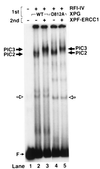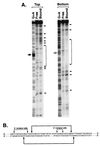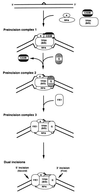Assembly, subunit composition, and footprint of human DNA repair excision nuclease
- PMID: 9618470
- PMCID: PMC22593
- DOI: 10.1073/pnas.95.12.6669
Assembly, subunit composition, and footprint of human DNA repair excision nuclease
Abstract
The assembly and composition of human excision nuclease were investigated by electrophoretic mobility shift assay and DNase I footprinting. Individual repair factors or any combination of up to four repair factors failed to form DNA-protein complexes of high specificity and stability. A stable complex of high specificity can be detected only when XPA/RPA, transcription factor IIH, XPC.HHR23B, and XPG and ATP are present in the reaction mixture. The XPF.ERCC1 heterodimer changes the electrophoretic mobility of the DNA-protein complex formed with the other five repair factors, but it does not confer additional specificity. By using proteins with peptide tags or antibodies to the repair factors in electrophoretic mobility shift assays, it was found that XPA, replication protein A, transcription factor IIH, XPG, and XPF.excision repair cross-complementing 1 but not XPC.HHR23B were present in the penultimate and ultimate dual incision complexes. Thus, it appears that XPC.HHR23B is a molecular matchmaker that participates in the assembly of the excision nuclease but is not present in the ultimate dual incision complex. The excision nuclease makes an assymmetric DNase I footprint of approximately 30 bp around the damage and increases the DNase I sensitivity of the DNA on both sides of the footprint.
Figures







Similar articles
-
Mechanism of open complex and dual incision formation by human nucleotide excision repair factors.EMBO J. 1997 Nov 3;16(21):6559-73. doi: 10.1093/emboj/16.21.6559. EMBO J. 1997. PMID: 9351836 Free PMC article.
-
Order of assembly of human DNA repair excision nuclease.J Biol Chem. 1999 Jun 25;274(26):18759-68. doi: 10.1074/jbc.274.26.18759. J Biol Chem. 1999. PMID: 10373492
-
Strong functional interactions of TFIIH with XPC and XPG in human DNA nucleotide excision repair, without a preassembled repairosome.Mol Cell Biol. 2001 Apr;21(7):2281-91. doi: 10.1128/MCB.21.7.2281-2291.2001. Mol Cell Biol. 2001. PMID: 11259578 Free PMC article.
-
DNA damage recognition during nucleotide excision repair in mammalian cells.Biochimie. 1999 Jan-Feb;81(1-2):39-44. doi: 10.1016/s0300-9084(99)80036-4. Biochimie. 1999. PMID: 10214908 Review.
-
Xeroderma pigmentosum and molecular cloning of DNA repair genes.Anticancer Res. 1996 Mar-Apr;16(2):693-708. Anticancer Res. 1996. PMID: 8687116 Review.
Cited by
-
Structural and functional evidence that Rad4 competes with Rad2 for binding to the Tfb1 subunit of TFIIH in NER.Nucleic Acids Res. 2013 Feb 1;41(4):2736-45. doi: 10.1093/nar/gks1321. Epub 2013 Jan 7. Nucleic Acids Res. 2013. PMID: 23295669 Free PMC article.
-
A scanning-to-incision switch in TFIIH-XPG induced by DNA damage licenses nucleotide excision repair.Nucleic Acids Res. 2023 Feb 22;51(3):1019-1033. doi: 10.1093/nar/gkac1095. Nucleic Acids Res. 2023. PMID: 36477609 Free PMC article.
-
Nucleotide Excision Repair and Impact of Site-Specific 5',8-Cyclopurine and Bulky DNA Lesions on the Physical Properties of Nucleosomes.Biochemistry. 2019 Feb 12;58(6):561-574. doi: 10.1021/acs.biochem.8b01066. Epub 2019 Jan 7. Biochemistry. 2019. PMID: 30570250 Free PMC article.
-
Disorders of nucleotide excision repair: the genetic and molecular basis of heterogeneity.Nat Rev Genet. 2009 Nov;10(11):756-68. doi: 10.1038/nrg2663. Epub 2009 Oct 7. Nat Rev Genet. 2009. PMID: 19809470 Review.
-
Novel irreversible small molecule inhibitors of replication protein A display single-agent activity and synergize with cisplatin.Mol Cancer Ther. 2011 Oct;10(10):1796-806. doi: 10.1158/1535-7163.MCT-11-0303. Epub 2011 Aug 16. Mol Cancer Ther. 2011. PMID: 21846830 Free PMC article.
References
-
- Sancar A. Annu Rev Biochem. 1996;65:43–81. - PubMed
-
- Mu D, Park C H, Matsunaga T, Hsu D S, Reardon J T, Sancar A. J Biol Chem. 1995;270:2415–2418. - PubMed
-
- Mu D, Hsu D S, Sancar A. J Biol Chem. 1996;271:8285–8294. - PubMed
-
- Moggs J G, Yarema K J, Essigmann J M, Wood R D. J Biol Chem. 1996;271:7177–7186. - PubMed
Publication types
MeSH terms
Substances
Grants and funding
LinkOut - more resources
Full Text Sources

